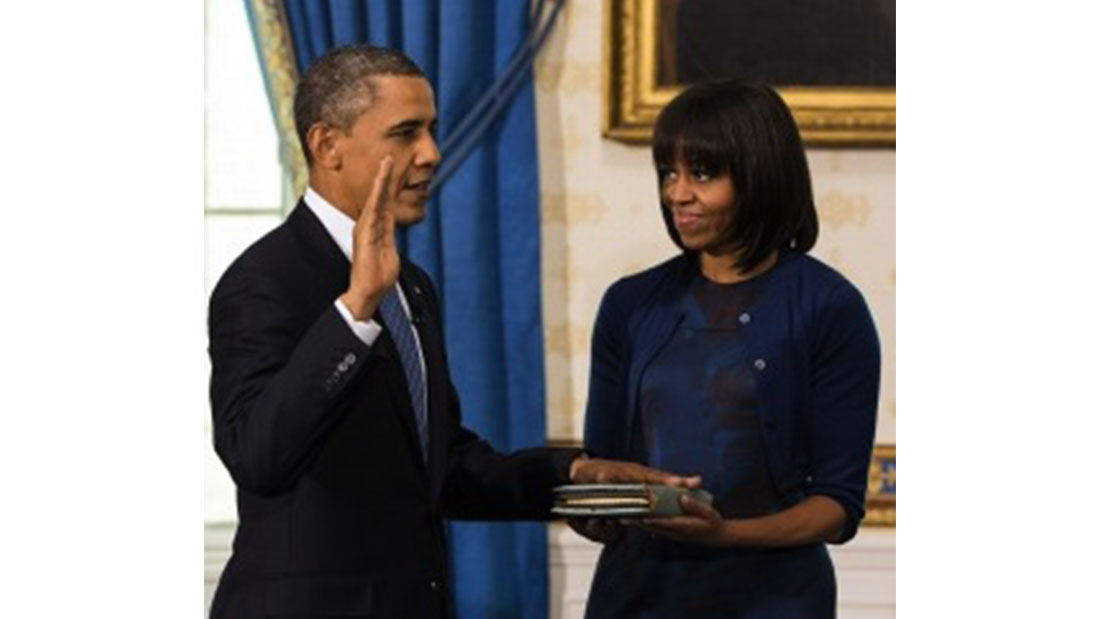
03 Feb Committing to Change: A Battle Between Hope and Fear
In his inauguration speech Obama articulates a bold and progressive vision, which may take generations to achieve. While many are relieved to hear the agenda he sets out, there are others who just plain disagree with him. Reactions to his speech seem to fall into two main camps. Those who’ve been hurt by empty promises are cynical. Others are energised by signals of change.
My own interest lies in how we grapple with the tension between our need for hope and a direction we can believe in on one hand and the risks that it will all amount to nothing.
(Official White House Photo by Pete Souza)
First Lady Michelle Obama holds the Robinson family Bible as President Barack Obama takes the oath of office during the official swearing-in ceremony in the Blue Room of the White House on Inauguration Day, Sunday, Jan. 20, 2013.
Any leader who sets out to communicate a compelling vision will face this challenge. She will find in her audience the same range of sentiments evoked by Obama. The battle between hope and fear, lies at the core of committing or not committing to change.
Let’s look at the dynamics that underpin the forces of hope and fear in closer detail.
Courage and the Potential for Disappointment
It takes courage for a leader to communicate a bold vision and to ask others to join them. To do so requires that they uncover the solid foundations of their leadership. They need to know who they are and what they stand for. It takes a similar courage for us to challenge destructive personal habits or take more responsibility for our impact on the world.
Many of us shy away from exposing ourselves in this way. Revealing what we value comes with risks, especially when it involves reaching for something other than the status quo. Others may agree or deride us, we might live up to our vision or fall short.
It’s hardly surprising therefore that many of us fudge it when it comes to stating what’s really important to us. We think in generalities or look to the external environment for cues as to what others expect from us. We hedge our bets. Or we do nothing, just letting things roll along, we make the no-choice choice.
Self protection and Smouldering Discontent
Though we may keep our treasure buried for safekeeping, the desire for something better rarely goes away. It simmers as a frustration with the way the world is, or the chronic problems in our workplace. It surfaces in the form of complaints about the short-comings of our boss or our politicians. Even the deepest cynicism is a yearning for something more…The amount of energy tied up in ingrained wariness and contempt for others efforts reflects the depths of our potential for disappointment. But protecting ourselves in this way comes at a price.
Relying on Others
As a society we have fallen into the trap of hoping that someone else will take the risks and pursue the cause for us. We outsource not only leadership, but our own sense of initiative. We rely on others to do it for us, then are furious if and when they fall short. As any bookmaker might explain, we have a lot riding on them.
Mediocrity and Half-heartedness
When we stop short of uncovering what we value and what that looks like in action we set mediocre goals. In the short-term this may seem like the easiest approach. However mediocre goals are hard work because they don’t mean enough to us – or to others.
If we lead others our directives can come across as half-hearted or ambiguous. Mixed messages betray our lack of conviction and/or confidence, which staff then mirror. We spend our time fighting spot fires and dealing with organisational symptoms such as lack-lustre performance, poor returns and eventually the threat to viability.
Moods and Addictions
When we opt for a tried and safe vision, we may avoid the risks that come with bold dreams, but we suffer the consequences of our compromise. Individually we experience moods and frustrations. Substance abuse is a common way of quieting our disappointments.
Learning to Deal with the Risks
Ok, you get the point. So how then can we invest in courageous visions that face up to the honerous challenges of our time, whilst reconciling the chance that we may fail in trying to do so?
Option 1: Ignore Them
One way is to ignore the risks of failure, to be so taken by our vision that we’re driven by it. People who take this approach run on sheer determination. They deal with the risks by not seeing them. While those around them may be inspired, they often feel nervous. Challenging the ideas of leaders who are strapped to their mission can be career threatening. Ventures that thrive for a while under this style of leadership can fail to spot a turn in the road ahead, and burn out spectacularly.
Option 2: Keep Them Close
A better way in my view, is to keep the potential for failure close to us, to pay attention to our progress and to adjust, adjust, adjust. This path requires that our vigilance matches our will.
On the Whitehouse steps, Obama emphasised that a nation’s founding vision, while an important guiding force, is insufficient. He warned against resting on the premises contained in the nation’s Constitution by assuming them to be reality.
The same is true for individuals and organisations. It’s dangerous to confuse our aspirations or even our values with the current reality of our leadership or business practice. Developing a strategic plan is not the same as implementing that plan. The achievement of our visions relies not only on the wisdom of our vision, but on our ability to forge alliances, access essential resources and deal with the unexpected.
To be successful we need to recognise the difference between our aspirations and our performance. Understanding the gap between what we plan, what we follow through on and the results we achieve, defines our future work.
Monitoring our progress is a sober undertaking. It demands that we learn from our experience. Obama refers to this challenge as: “the never-ending journey to bridge these words with the reality of our time.”
In order to bridge our vision and reality, reflection and constructive self-appraisal must find a place beside the inspiration, which causes our heart to quicken and our imagination to fire.
Reflection
What is your vision? How willing are you to stand behind it?
How do you measure your progress?
What measures does your organisation have in place to track its performance?
How in touch are you with the experience of your staff, stakeholders and customers?


No Comments